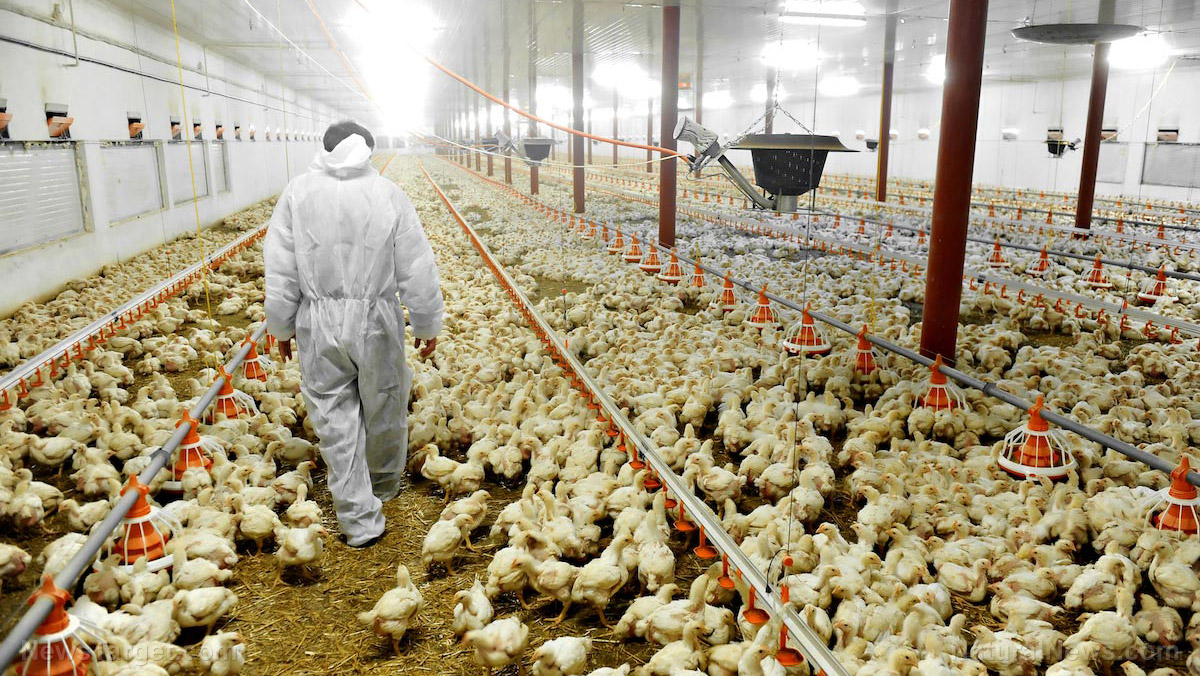
Advertisement
Recent controversy in the U.K. about the prospect of U.S. chickens hitting British supermarkets post-Brexit has shed light on the horrific conditions these animals face, and it’s enough to make even the most passionate poultry eater go full vegan.
Why did the idea of these chickens being sold in the U.K. spark such a fierce Cabinet row? The fact that it is washed in chlorine is only part of the problem. It’s the reason that such an unappetizing measure is needed in the first place: the unfathomable conditions under which these chickens are bred and raised. (Related: Why factory farming will ultimately lead to mass global starvation.)
The U.S. does not have any minimum space requirements when it comes to breeding chicken, nor does it have rules regarding lighting levels in sheds or maximum allowable levels of ammonia to indicate the amount of fecal matter and urine present. The U.K. and Europe have laws governing such matters, whereas unlimited amounts of waste can and do fester inside American sheds. This helps explain why 97 percent of our country’s birds have to be cleaned in chlorine after being slaughtered, adding to the concern.
U.K. Environment Secretary Michael Gove spoke out against a trade deal that would see American chickens sold in U.K. stores, after Trade Secretary Liam Fox indicated he would consider dropping an EU ban on importing American chicken should it stand in the way of securing a trade deal with America following Brexit.
Farmers reveal chicken industry horrors
The American poultry industry is largely controlled by big agricultural firms, and some whistleblower farmers have provided some chilling insight into the lives of these poor animals.

One North Carolina farmer says that because the birds are bred for breast meat, they are too heavy to stand up and must spend their entire lives squatting. He likens them to “two toothpicks sticking out of a grape.” This position places them on the litter 95 percent of the time, which he describes as a mixture of pine shavings and fecal matter from the current flock as well as those that preceded it. Infections on the underside of their chests from contact with the filthy litter are common, with around 1,000 of the 30,000 chickens he raises every six weeks dying before reaching maturity.
He says, “Their flesh would rot and, when you have them crammed in so tight, they will walk over other birds if they want to get to the food or scratch the others and cause a wound. It is awful.”
He became so disgusted with the industry’s practices that he quit the poultry business entirely.
Big Ag rewards efficiency, disregards animal welfare
One big problem is the way the American system is structured, with almost all of the nation’s chicken farmers contracted by big producers that supply them with the chicks themselves along with feed and equipment. The farmers are paid using a “tournament system” wherein the farmer who can produce the most meat using the least feed is rewarded for his efficiency, while those who do not perform see money deducted from their base pay. This system essentially rewards farmers for cutting corners when it comes to animal welfare.
American chickens cost 20 percent less than British chickens, and big producers have cross-bred and interbred the animals to create “mutant” chickens that can grow bigger in less time. In fact, FreeFromHarm.org reports that chickens that are bred for their meat are among the most genetically manipulated animals there are, being forced to grow at a rate that is 65 times faster than their normal growth rate.
These “Frankenchickens” grow so fast that they simply cannot move around, and spend their lives sitting in their own waste before being killed. And unlike in the U.K. and Europe, there are no laws that chickens must be stunned unconscious prior to slaughter in the U.S., where 9 billion of the birds were slaughtered last year alone.
It’s easy to see why U.K. ministers were so outraged by the idea of these chickens being sold in their grocery stores, and it also begs the question: Why is this allowed to occur in the U.S.?
Sources include:
Submit a correction >>
This article may contain statements that reflect the opinion of the author
Advertisement
Advertisements















